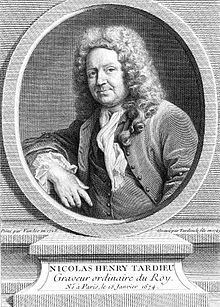Nationality French Name Nicolas-Henri Tardieu Children Jacques-Nicolas Tardieu | Known for Engraving Role Engraver | |
 | ||
Died January 27, 1749, Paris, France | ||
Nicolas-Henri Tardieu, called the "Tardieu the elder", (18 January 1674 - 27 January 1749) was a prominent French engraver, known for his sensitive reproductions of Antoine Watteau's paintings. He was appointed graveur du roi (King's Engraver) to King Louis XV of France. His second wife, Marie-Anne Horthemels, came from a family that included engravers and painters. She is known as an engraver in her own right. Nicolas-Henri and Marie-Anne Tardieu had many descendants who were noted artists, most of them engravers.
Contents
Biography
Nicolas-Henri Tardieu was born in Paris on 18 January 1674 and was baptized three days later. He was the son of Nicolas Tardieu, bourgeois de Paris, and Marie Aymiee [sic]. His father was a boilermaker, as were his two younger brothers. Possibly Nicolas-Henri used scraps of copper from his father's workshop for his early engravings. He was a student of Pierre Lepautre, Gerard Audran and Benoit Audran. Tardieu married Louise-Francoise Aveline, daughter of Jean Aveline and a relative of the engraver Pierre Aveline, on 1 September 1706 in the church of Saint-Jacques-du-Haut-Pas. Louise-Francoise was the widow of Laurent Baron, the commissioner of the oratory. Louise had two children from her first marriage, and had just one with Tardieu, Denis, born on 31 August 1707. She died on 18 November 1708.
On 20 October 1712 Tardieu married again, to Marie-Anne Horthemels. She was the widow of the pastry-maker Germain Le Coq, who had worked for King Louis XIV of France (1638–1715) and for the Duchess of Burgundy. Marie-Anne was one of three daughters of the Dutch bookseller Daniel Horthemels. Her sister Louise-Magdeleine Horthemels was an active reproductive engraver who married Charles-Nicolas Cochin, graveur du roi. Her other sister married Alexis Simon Belle, peintre ordinaire du roi. His second wife had a talent for engraving, and is known for her portraits of Cardinal de Bissy, Cardinal de Rohan and the Regent Philippe II, Duke of Orleans. She died on 24 March 1727.
Tardieu was accredited to the Academy on 29 October 1712. He was received as a member of the Royal Academy and graveur du roi (official engraver to King Louis XV of France) on 29 November 1720 for his "Engraved portrait of the Duke of Antin" (Louis Antoine de Pardaillan de Gondrin), after a painting by Hyacinthe Rigaud. As one of the most prominent engravers of his time, Tardieu was commissioned to engrave plates for several major publications. He made engravings for the Crozat Collection and the Galerie de Versailles.
Tardieu died on 27 January 1749 at his house on the Rue Saint-Jacques in Paris and was buried the next day. He was survived by his brother, Claude Tardieu, and his son, Jacques-Nicolas Tardieu.
Legacy
Tardieu had four sons, each of whom passed on the tradition of engraving or other arts to their descendants. He had taught his son Jacques-Nicolas Tardieu (1718-1759), also a designer and engraver, who was appointed graveur ordinaire du roi. Tardieu also taught engraving to his nephew, Pierre Francois Tardieu (c.1711 - 1774). The engraver Bernard Baron (1700-1762) was another of his pupils who gained distinction in his profession. Laurent Cars and Jacques-Philippe Le Bas were also pupils, later to be teachers themselves. His grandson Jean-Charles Tardieu became a well-known painter. The last of the line of "clever engravers" that he founded died in 1844.
Jean-Baptiste van Loo painted Tardieu's portrait, which was placed in the galleries of Versailles.
Work
Of at least eight engravers by the name of Tardieu, Nicolas-Henri was the most notable, one of the most prominent engravers in France for his versatile use of point and graver. He was author of many engravings of the highest quality. Tardieu held true to the principles of his master, Gerard Audran. He was an opponent of the fashionable trend towards less serious subjects, and attempted to pass on his traditionalist views to his pupils. Tardieu engraved several of Watteau's paintings. His version of Champs Elysees and Embarcation for Cythera are excellent interpretations of Watteau's work as etchings. Tardieu had an extraordinary ability to retain the "silvery" atmosphere of Watteau's paintings in his engravings.
Prints
Some of his best prints include:
Portraits
Classical subjects
Religious subjects
Other works
Other works that have been preserved include:
